April 15, 1452 - May 2, 1519
Da Vinci was an Italian painter, draftsman, sculptor, architect, and engineer. Da Vinci was a great engineer and inventor who designed buildings, bridges, canals, forts and war machines. He kept huge notebooks sketching his ideas. Among these, he was fascinated by birds and flying and his sketches include such fantastic designs as flying machines. These drawings demonstrate a genius for mechanical invention and insight into scientific inquiry, truly centuries ahead of their time. His greater fame lies in being one of the greatest painters of all times, best known for such paintings as the Mona Lisa and The Last Supper.
Personal Life The first known biography of Leonardo was published in 1550 by Giorgio Vasari who wrote
Vite de' piu eccelenti architettori, pittori e scultori italiani ("The lives of the most excellent Italian architects, painters and sculptors"), and later became an independent painter in Florence. Most of the information collected by Vasari was from first-hand accounts of Leonardo's contemporaries, (Vasari was only a child when Leonardo died), and it remains the first reference in studying Leonardo's life.
Leonardo was born in Anchiano, near Vinci, Italy. He was an illegitimate child. His father, Ser Piero da Vinci was a young lawyer and his mother, Caterina, was probably a peasant girl. It has also been suggested, albeit on scanty evidence, that she was a Middle Eastern slave owned by Piero. However, the latter theory is unlikely to be true.
As he was born before modern naming conventions developed in Europe, his full name was "Leonardo di ser Piero da Vinci", which means "Leonardo, son of Mister Piero, from Vinci". Leonardo himself simply signed his works "Leonardo" or "Io, Leonardo" ("I, Leonardo"). Most authorities therefore refer to his works as "Leonardos", not "da Vincis". Presumably he did not use his father's name because of his illegitimate status.
Leonardo grew up with his father in Florence. Here, he started drawing and painting. His early sketches were of such quality that his father soon showed them to the painter Andrea del Verrocchio who subsequently took the fourteen-year old Leonardo on as an apprentice. Later, he became an independent painter in Florence.
In 1476, he was accused anonymously, along with three other men, of sodomy with a 17 year-old model, Jacopo Saltarelli, who was a notorious male prostitute. After two months in jail, he was acquitted because no witnesses stepped forward. For some time afterwards, Leonardo and the others were kept under observation by Florence's Officers of the Night - a kind of Renaissance vice squad, charged with suppressing the practice of sodomy, which a majority of male Florentines engaged in, as shown by surviving legal records of the Podestá and the Officers of the Night.
Modern critics contend that Leonardo's love of boys was well-known even in the sixteenth century. Rocke reports that in a fictional dialogue on l'amore masculino (male love) written by the contemporary art critic and theorist Gian Paolo Lomazzo, Leonardo appears as one of the protagonists and declares, "Know that male love is exclusively the product of virtue which, joining men together with the diverse affections of friendship, makes it so that from a tender age they would enter into the manly one as more stalwart friends." In the dialogue, the interlocutor inquires of Leonardo about his relations with his assistant, Salai, "Did you play the game from behind which the Florentines love so much?"
Leonardo kept his private life particularly secret, and there is no evidence that Leonardo was ever intimately involved with any woman, nor in a close friendship with one. He also surrounded himself with handsome young men throughout his life, and his art reflects an appreciation of androgynous beauty. It has, therefore, been assumed that he was a homosexual. One of his loves may have been Gian Giacomo Caprotti da Oreno (nicknamed Salai (Little Devil)). Gian entered Leonardo's household around 1488 at the age of 10, becoming his servant and assistant.
In 1506, Leonardo met Count Francesco Melzi, the fifteen year old son of a Lombard aristocrat. Salai eventually accepted Melzi's continued presence and the three undertook various journeys throughout Italy. Though Salai was always introduced as Leonardo's "pupil", he never produced any work of artistic merit. Melzi, however, became his pupil and life companion. Leonardo had many other friends who are now figures renowned in their fields, or for their influence on history; these included Niccolò Machiavelli, Cesare Borgia and Franchinus Gaffurius.
Disregarding the controversy of homosexuality, it is clear from the works of Leonardo and his early biographers, that he was a man of high integrity and very sensitive to moral issues. Hereby, it should be noted that Leonardo was a vegetarian at least a part of his life and often bought birds just to release them. He was also the respected judge on the matters of beauty and elegance, particularly in pageantry.
Relationships Leonardo kept his private life particularly secret, going as far as writing his journals in code. He also claimed to have a distaste of physical relations: The act of procreation and anything that has any relation to it is so disgusting that human beings would soon die out if there were no pretty faces and sensuous dispositions, a comment later interpreted by Freud, in an analysis of the artist, as indicative of his "frigidity" (Gesammelte Werke bd VIII, 1909-1913). He concludes that Leonardo is driven by a homosexual libido, one that is sublimated in his scientific investigations. Indeed, Leonardo surrounded himself with handsome youths throughout his life, and allowed his art to reflect an appreciation of masculine beauty. His lasting and loving relationship with young men and lack of close relationships with women, together with surviving legal records and contemporary writings have led many modern historians to conclude that he had a strong erotic interest, one focused exclusively on males.
The first known instance of his interest in youths occurred in 1476. While still living with Verrocchio, he was twice accused anonymously of sodomy with a 17 year-old model, Jacopo d¹Andrea Saltarelli, a boy already known to the authorities for his sexual escapades with men. After two months in jail, he was acquitted because no witnesses stepped forward. For some time afterwards, Leonardo and the others were kept under observation by Florence's Officers of the Night - a Renaissance organisation charged with suppressing the practice of sodomy, as shown by surviving legal records of the Podesta and the Officers of the Night.
Leonardo's alleged love of boys was a topic of discussion even in the sixteenth century. In "Il Libro dei Sogni " (The Book of Dreams) a fictional dialogue on l'amore masculino (male love) written by the contemporary art critic and theorist Gian Paolo Lomazzo, Leonardo appears as one of the protagonists and declares, "Know that male love is exclusively the product of virtue which, joining men together with the diverse affections of friendship, makes it so that from a tender age they would enter into the manly one as more stalwart friends." In the dialogue, the interlocutor inquires of Leonardo about his relations with his assistant, il Salaino, "Did you play the game from behind which the Florentines love so much?" Leonardo answers, "And how many times! Keep in mind that he was a beautiful young man, especially at about fifteen."
Gian Giacomo Caprotti da Oreno, nicknamed il Salaino ("The Little Unclean One" i.e., the devil), was described by Vasari as "a graceful and beautiful youth with fine curly hair, in which Leonardo greatly delighted." Il Salaino entered Leonardo's household in 1490 at the age of 10. The relationship was not an easy one. A year later Leonardo made a list of the boy¹s misdemeanors, calling him "a thief, a liar, stubborn, and a glutton." The "Little Devil" had made off with money and valuables on at least five occasions, and spent a fortune on apparel, among which twenty four pairs of shoes. Nevertheless, il Salaino remained his companion, servant and assistant for the next thirty years, and Leonardo's notebooks during their early years contain pictures of a handsome, curly-haired adolescent.
Il Salaino's name also appears (crossed out) on the back of an erotic drawing (ca. 1513) by the artist, The Incarnate Angel, at one time in the collection of Queen Victoria. It is seen as a humorous and revealing take on his major work, St. John the Baptist, also a work and a theme imbued with homoerotic overtones by a number of art critics such as Martin Kemp and James Saslow (Saslow, 1986, passim). Another erotic work, found on the verso of a foglio in the Atlantic Codex, depicts il Salaino's behind, towards which march several penises on two legs (Augusto Marinoni, in "Io Leonardo", Mondadori, Milano 1974, pp.288, 310). Some of Leonardo's other works on erotic topics, his drawings of heterosexual human sexual intercourse, were destroyed by a priest who found them after his death.
In 1506, Leonardo met Count Francesco Melzi, the 15 year old son of a Lombard aristocrat. Melzi himself, in a letter, described Leonardo's feelings towards him as a sviscerato et ardentissimo amore ("a passionate and most fiery love"). (Crompton, p.269) Salai eventually accepted Melzi's continued presence and the three undertook journeys throughout Italy. Though Salai was always introduced as Leonardo's "pupil", he never produced any work of artistic merit. Melzi, however, became Leonardo's pupil and life companion, and is considered to have been his favorite student.
Both of these relationships follow the pattern of eroticized apprenticeships which were frequent in the Florence of Leonardo's day, relationships which were often loving and not infrequently sexual. See Historical pederastic couples Besides them, Leonardo had many other friends who are now figures renowned in their fields, or for their influence on history. These included Cesare Borgia, in whose service he spent the years of 1502 and 1503. During that time he also met Niccolò Machiavelli, with whom later he was to develop a close friendship. Also among his friends are counted Franchinus Gaffurius and Isabella d'Este, whose portrait he drew while on a journey which took him through Mantua.
Professional Life 
The earliest known dated work of Leonardo's is a drawing done in pen and ink of the Arno valley, drawn on the 5th of August 1473. It is assumed that he had his own workshop between 1476 and 1478, receiving two orders during this time.From around 1482 to 1499, Ludovico Sforza, Duke of Milan, employed Leonardo and permitted him to operate his own workshop complete with apprentices. It was here that seventy tons of bronze that had been set aside for Leonardo's "Gran Cavallo" horse statue were cast into weapons for the Duke in an attempt to save Milan from the French under Charles VIII in 1495.When the French returned under Louis XII in 1498, Milan fell without a fight, overthrowing Sforza.
Leonardo stayed in Milan for a time, until one morning when he found French archers using his life-size clay model of the "Gran Cavallo" for target practice. He left with Salai and his friend Luca Pacioli (the first man to describe double-entry bookkeeping) for Mantua, moving on after 2 months to Venice (where he was hired as a military engineer), then briefly returning to Florence at the end of April 1500.
In Florence he entered the services of Cesare Borgia, the son of Pope Alexander VI, acting as a military architect and engineer; with Cesare he travelled throughout Italy. In 1506 he returned to Milan, now in the hands of Maximilian Sforza after Swiss mercenaries had driven out the French.
From 1513 to 1516, he lived in Rome, where painters like Raphael and Michelangelo were active at the time, though he did not have much contact with these artists. However, he was probably of pivotal importance in the relocation of David (in Florence), one of Michelangelo's masterpieces, against the artist's will.
In 1515 Francis I of France retook Milan, and Leonardo was commissioned to make a centrepiece (a mechanical lion) for the peace talks between the French king and Pope Leo X in Bologna, where he must have first met the King.
In 1516, he entered Francis' service, being given the use of the manor house Clos Lucé (also called "Cloux") next to the king's residence at the royal Chateau Amboise. The King granted Leonardo and his entourage generous pensions: the surviving document lists 1000 écus for the artist, 400 for Melzi (named "apprentice") and 100 for Salai (named "servant").
In 1518 Salai left Leonardo and returned to Milan, where he eventually perished in a duel. Francis became a close friend.Leonardo da Vinci died at Clos Lucé, France, on 2nd May, 1519. According to his wish, 60 beggars followed his casket. He was buried in the Chapel of Saint-Hubert in the castle of Amboise. Although Melzi was his principle heir and executor, Salai was not forgotten; he received half of Leonardo's vineyard.
Art 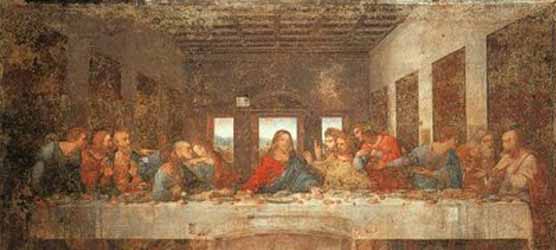
Leonardo pioneered new painting techniques in many of his pieces. One of them, a colour shading technique called "Chiaroscuro", used a series of glazes custom-made by Leonardo. It is characterized by subtle transitions between colour areas, creating an atmospheric haze or smoky effect. Chiaroscuro is a technique of bold contrast between light and dark.
Early works in Florence (1452-1482)
Leonardo was apprenticed to the artist Verrocchio in Florence when he was about 15. In 1476 Leonardo worked with Verrocchio to paint for the friars of Vallombrosa The Baptism of Christ. He painted the angel at the front and the landscape, and the difference between the two artists' work can be seen, with Leonardo's finer blending and brushwork. Giorgio Vasari told the story that when Verrochio saw Leonardo's work he was so amazed that he resolved never to touch a brush again.
Leonardo's first painting completed wholly by himself was the Madonna and Child painting completed in 1478, he also painted at the same time a picture of a little boy eating sherbert.
In 1480-81 he created a small Annunciation painting which is now in the Louvre. In 1481 he painted an unfinished work of St. Jerome. Between 1481 and 1482 he started a painting called The Adoration of the Kings (also known as The Adoration of the Magi). He made extensive, ambitious plans and many drawings for the painting, but it was not finished, as Leonardo's services had been accepted by the Duke of Milan, to which he traveled.
Milan (1482-1499)Leonardo spent 17 years in Milan under the services of Duke Ludovico (between 1482 and 1499). He did many paintings, sculptures, and drawings during this time. He also designed court festivals, and did many of his sketches related to engineering. He was given basically a free reign to work on any project he chose, though he left many projects unfinished, completing only about six paintings during this time. This included The Last Supper (Ultima Cena or Cenacolo, in Milan) 1498 and Virgin of the Rocks. He worked on many of his notebooks between 1490 and 1495.He painted the Virgin of the rocks in 1494.
In 1499 he painted Madonna and Child with St. Anne.He often planned grandiose paintings with many drawings and sketches, only to leave the projects unfinished. One of his projects involved making plans and models for a monumental seven metre (24 ft) high horse statue in bronze called "Gran Cavallo". Because of war with France, the project was never finished. (In 1999 a pair of full-scale statues based on his plans were cast, one erected in Grand Rapids, Michigan, the other in Milan.) The Hunt Museum in Limerick, Ireland has a small bronze horse, thought to be the work of an apprentice from Leonardo's original design.
The French invaded Milan in 1499, and Ludovico Sforza lost control. Leonardo was forced to search for a new patron.
Nomadic Period - Italy and France (1499-1519)
Between 1499 and 1516 Leonardo worked for a number of people, travelling around Italy doing several commissions, before moving to France in 1516. This has been described as a 'Nomadic Period'.
In 1500 he went to Mantua where he sketched a portrait of the Marchesa Isabella d'Este. He left for Venice in 1501, and soon after returned to Florence.After returning to Florence, he was commissioned for a large public mural, The Battle of Anghiari; his rival Michelangelo was to paint the opposite wall. After producing a fantastic variety of studies in preparation for the work, he left the city, with the mural unfinished due to technical difficulties. The painting was destroyed in a war in the middle of the sixteenth century.
He began work on the Mona Lisa (also known as La Gioconda, now at the Louvre in Paris) in 1503, which he did not finish until 1506. He most likely kept it with him at all times, and did not travel without it. Thousands of people see it each year in the Louvre, perhaps drawing their own interpretation on what is known as the Mona Lisa's most infamous and enigmatic feature - her smile. It is well known that Leonardo made extensive use of many tricks in this painting, including the so-called Golden Ratio. The name Mona Lisa is not the one given to the piece of art at the time, nor was it known by this title until much later. The Mona Lisa was probably his favourite piece.
He painted St Anne in 1509. Between 1506 and 1512, he lived in Milan and under the patronage of the French Governor Charles d'Amboise, he painted several other paintings. These included The Leda and the Swan, known now only through copies as the original work did not survive. He painted a second version of The Virgin of the Rocks (1506-1508). While under the patronage of Pope Leo X, he painted St. John the Baptist (1513-1516).
During his time in France, Leonardo made studies of the Virgin Mary for The Virgin and Child with St. Anne, and many drawings and other studies.
Science and Engineering Renaissance humanism saw no mutually exclusive polarities between the sciences and the arts, and as impressive and innovative as Leonardo's artistic work are his studies in science and engineering, recorded in notebooks comprising some 13,000 pages of notes and drawings, which fuse art and science. These notes were made and maintained through Leonardo's travels through Europe, during which he made continual observations of the world around him. He was left-handed and used mirror writing throughout his life. This is explainable by the fact that it is easier to pull a quill pen than to push it; by using mirror-writing, the left-handed writer is able to pull the pen from right to left.
His approach to science was an observational one: he tried to understand a phenomenon by describing and depicting it in utmost detail, and did not emphasize experiments or theoretical explanations. Throughout his life, he planned a grand encyclopedia based on detailed drawings of everything. Since he lacked formal education in Latin and mathematics, contemporary scholars mostly ignored Leonardo the scientist.
He participated in autopsies and produced many extremely detailed anatomical drawings, planning a comprehensive work of human and comparative anatomy. Around the year 1490, he produced a study in his sketchbook of the Canon of Proportions as described in recently rediscovered writings of the Roman architect Vitruvius. The study, called the Vitruvian Man, is one of his most well-known works.

Vitruvian man - 1498
Leonardo da Vinci draws the human body Leonardo started to discover the anatomy of the human body at the time he was apprenticed to Andrea del Verrocchio, as his teacher insisted that all his pupils learn anatomy. As he became successful as an artist, he was given permission to dissect human corpses at the hospital Santa Maria Nuova in Florence. Later he dissected also in Milano in the hospital Maggiore and in Rome in the hospital Santo Spirito (the first mainland Italian hospital).
From 1510 to 1511 he collaborated with the doctor Marcantonio della Torre (1481 to 1511). In 30 years, Leonardo dissected 30 male and female corpses of different ages. Together with Marcantonio, he prepared to publish a theoretical work on anatomy and made more than 200 drawings. However, his book was published only in 1580 (long after his death) under the heading Treatise on painting.Leonardo drew many images of the human skeleton, and was the first to describe the double S form of the backbone.
He also studied the inclination of pelvis and sacrum and stressed that sacrum was not uniform, but composed of five vertebrae. He was also able to represent exceptionally well the human skull and cross-sections of the brain (transversal, sagittal, and frontal). He drew many images of the lungs, mesentery, urinary tract, sex organs, and even coitus. He was one of the first who drew the fetus in the intrauterine position (he wished to learn about "the miracle of pregnancy"). He often drew muscles and tendons of the cervical muscles and of the shoulder.
He was a master of topographic anatomy. He not only studied the anatomy of human, but also of other beings. It is important to note that he was not only interested in structure but also in function, so he was anatomist and physiologist at the same time. Because he actively searched for bodily deformed people to paint them, he is also considered to be the beginner of caricature.His study of human anatomy led also to the design of the first known robot in recorded history.
The design, which has come to be called Leonardo's robot, was probably made around the year 1495 but was rediscovered only in the 1950s. It is not known if an attempt was made to build the device. He correctly worked out how heart valves eddy the flow of blood yet he was unaware of circulation as he believed that blood was pumped to the muscles where it was consumed. A diagram drawing Leonardo did of a heart inspired a British heart surgeon to pioneer a new way to repair damaged hearts in 2005.
Inventions and engineering
Fascinated by the phenomenon of flight, Leonardo produced detailed studies of the flight of birds, and plans for several flying machines, including a helicopter powered by four men (which would not have worked since the body of the craft would have rotated) and a light hang-glider which could have flown.
On January 3, 1496 he unsuccessfully tested a flying machine he had constructed. PBS aired a special about the building and testing of a glider based on Leonardo's design. The glider was a resounding success.An armoured tank designed by Leonardo at the Château d'AmboiseThe interior of Leonardo da Vinci's armoured tankIn 1502 Leonardo da Vinci produced a drawing of a single span 720-foot (240 m) bridge as part of a civil engineering project for Sultan Beyazid II of Constantinople. The bridge was intended to span an inlet at the mouth of the Bosphorus known as the Golden Horn. It was never built, but Leonardo's vision was resurrected in 2001 when a smaller bridge based on his design was constructed in Norway.
Owing to his employment as a military engineer, his notebooks also contain several designs for military machines: machine guns, an armoured tank powered by humans or horses, cluster bombs, etc. even though he later held war to be the worst of human activities. Other inventions include a submarine, a cog-wheeled device that has been interpreted as the first mechanical calculator, and a car powered by a spring mechanism. In his years in the Vatican, he planned an industrial use of solar power, by employing concave mirrors to heat water. While most of Leonardo's inventions were not built during his lifetime, models of many of them have been constructed with the support of IBM and are on display at the Leonardo da Vinci Museum at the Chateau du Clos Luce in Amboise.
His notebooksLeonardo's notebooks were on four main themes; architecture, elements of mechanics, painting and human anatomy. These 'notebooks' - originally loose papers of different types and sizes, distributed by friends after his death - have found their way into major collections such as the Louvre, the Biblioteca Nacional de España, the Biblioteca Ambrosiana in Milan, and the British Library. The British Library has put a selection from its notebook (BL Arundel MS 263) on the web in its Turning the Pages section.
The Codex Leicester is the only major scientific work of Leonardo's in private hands. It is owned by Bill Gates, and is displayed once a year in different cities around the world.Why Leonardo did not publish or otherwise distribute the contents of his notebooks remains a mystery to those who believe that Leonardo wanted to make his observations public knowledge. Technological historian Lewis Mumford suggests that Leonardo kept notebooks as a private journal, intentionally censoring his work from those who might irresponsibly use it (the tank, for instance). They remained obscure until the 19th century, and were not directly of value to the development of science and technology.
In January 2005, researchers discovered the hidden laboratory used by Leonardo da Vinci for studies of flight and other pioneering scientific work in previously sealed rooms at a monastery next to the Basilica of the Santissima Annunziata, in the heart of Florence.
References:
Leonardo da Vinci - Wikipedia
Leonardo da Vinci BBC
Lists of Scientists Wikipedia
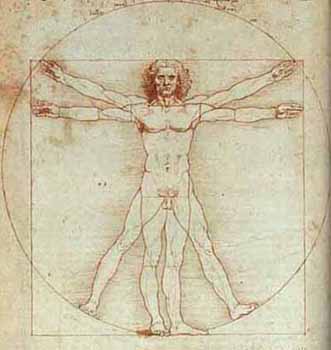
Flower of Life

The
Flower of Life - a symbol most commonly associated with New Age permutations of
Sacred Geometry, is a curiously universal emblem, appearing in religious contexts all over the globe.
The oldest example can still be seen at the Temple of Osiris at Abydos (one of many geometric arrangements of circles found there), it can also be seen in early Phoenecian, Assyrian, Indian, Asian, Middle Eastern, and later medieval art. The example at the Osireion, with its multiplicity of vesica pisces shapes, may represent the 'eyes' of Osiris- a symbol of the omniscience of the god.
This delicate net of overlapping circles arranged in a six-fold pattern is called the "flower of life" because it contains a number of other shapes within its deceptively simple pattern, leading some to call it the "blueprint of creation." By connecting points in the pattern, a multitude of patterns and shapes can be traced, including a tree of Life, pentagram, and various representations of three dimensional object.

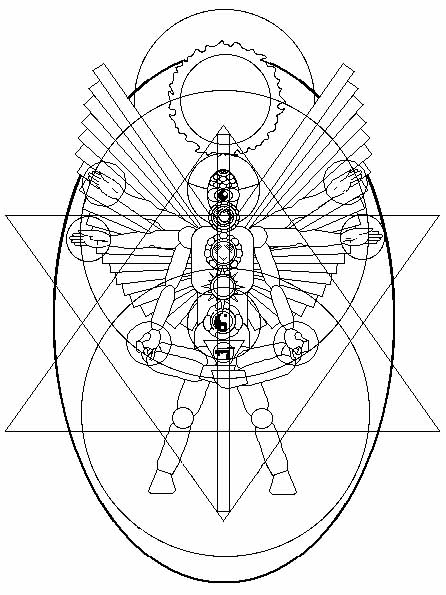
Chakras
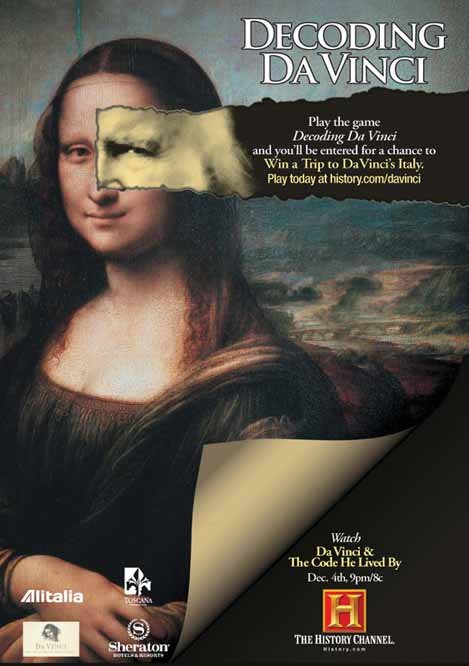 Da Vinci and the Code He Lived By
Da Vinci and the Code He Lived By
December 4, 2005 - 9:00 PM History Channel
Ellie Crystal interviews the historians from the program.
Articles in the News
 Video: Leonardo painting has coded 'soundtrack'
Video: Leonardo painting has coded 'soundtrack' MSNBC - November 13, 2007
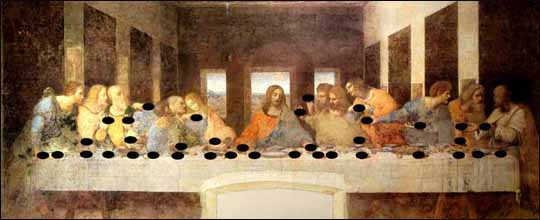 Leonardo's 'Last Supper' Hides True Da Vinci Code
Leonardo's 'Last Supper' Hides True Da Vinci Code BBC - November 10, 2007
A computer technician has claimed to have cracked a real Da Vinci code, by finding musical notes encoded in the masterpiece The Last Supper. Leonardo Da Vinci left clues to a 40-second musical composition in his painting, Giovanni Maria Pala said. Each loaf of bread in the picture represents a note, he said, which combine to sound "like a requiem". Alessandro Vezzosi, director of Tuscany's Da Vinci museum, said the theory was "plausible". The 15th century painting depicts Jesus' last meal with the 12 Apostles before his arrest and crucifixion.
Science decodes da Vinci's secrets News in Science - September 5, 2007
Leonardo da Vinci applied thin layers of colour on top of each other to create a rich texture and an almost 3D effect.
The Da Vinci Glow PhysOrg - October 6, 2005

http://crystalinks.com/davinci.html 


















 If a square is added to the long side of a golden rectangle, a larger golden rectangle is formed. Continuing this progression forms the basis for a nautilus spiral. The ratio of the distance between two points of a pentagram to its total width is in the golden proportion, as is the ratio of the height above the horizontal bar to that below, as is the ratio of a central part of a line to the outer part.
If a square is added to the long side of a golden rectangle, a larger golden rectangle is formed. Continuing this progression forms the basis for a nautilus spiral. The ratio of the distance between two points of a pentagram to its total width is in the golden proportion, as is the ratio of the height above the horizontal bar to that below, as is the ratio of a central part of a line to the outer part. Here are five elements, four of matter (earth, air, fire and water) and THE quintessential - spirit. These may be arrayed around the pentagrams points. The word quintessential derives from this fifth element - the spirit. Tracing a path around the pentagram, the elements are placed in order of density - spirit (or aether). fire, air, water, earth. Earth and fire are basal, fixed; air and water are free, flowing.
Here are five elements, four of matter (earth, air, fire and water) and THE quintessential - spirit. These may be arrayed around the pentagrams points. The word quintessential derives from this fifth element - the spirit. Tracing a path around the pentagram, the elements are placed in order of density - spirit (or aether). fire, air, water, earth. Earth and fire are basal, fixed; air and water are free, flowing. These point attributions are used in ritually inscribing, as a flourish of the hands or the athame, different forms of pentagram for invoking or banishing (grounding) each of the elementals according to the nature of the ritual. The line traces as illustrated for earth (the last stroke is optional).
These point attributions are used in ritually inscribing, as a flourish of the hands or the athame, different forms of pentagram for invoking or banishing (grounding) each of the elementals according to the nature of the ritual. The line traces as illustrated for earth (the last stroke is optional). A circle around a pentagram contains and protects. The circle symbolises eternity and infinity, the cycles of life and nature. The circle touching all 5 points indicates that the spirit, earth, air, water and fire are alll connected.
A circle around a pentagram contains and protects. The circle symbolises eternity and infinity, the cycles of life and nature. The circle touching all 5 points indicates that the spirit, earth, air, water and fire are alll connected. The pentagram may be inverted with one point down. The implication is of spirit subservient to matter, of man subservient to his carnal desires. The inverted pentagram has come to be seen by many pagans as representing the dark side and it is abhored as an evil symbol. Fundamental christians, indeed, see any form of pentagram as such. However, these are recent developments and the inverted pentagram is the symbol of Gardnerian second degree initiation, representing the need of the witch to learn to face the darkness within so that it may not later rise up to take control. The centre of a pentagram implies a sixth formative element - love/will which controls from within, ruling matter and spirit by Will and the controlled magickal direction of sexual energies. This is another lesson of initiation.
The pentagram may be inverted with one point down. The implication is of spirit subservient to matter, of man subservient to his carnal desires. The inverted pentagram has come to be seen by many pagans as representing the dark side and it is abhored as an evil symbol. Fundamental christians, indeed, see any form of pentagram as such. However, these are recent developments and the inverted pentagram is the symbol of Gardnerian second degree initiation, representing the need of the witch to learn to face the darkness within so that it may not later rise up to take control. The centre of a pentagram implies a sixth formative element - love/will which controls from within, ruling matter and spirit by Will and the controlled magickal direction of sexual energies. This is another lesson of initiation.